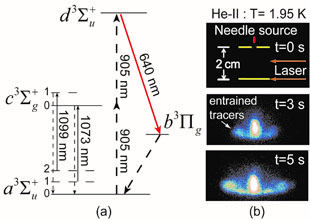Flow Visualization Technique development
He2* molecular tracers and laser-induced fluorescence
Metastable He2* molecules can be easily created in helium via ionization or excitation of ground-state helium atoms:

where “*” denotes excited electronic states [1]. These excited molecules are created in both electron-spin singlet (A1Σu+) state and triplet (a3Σu+) state. The singlet state molecules radiatively decay in a few nanoseconds [2], but the triplet state molecules have a lifetime of about 13 s due to a strongly forbidden spin flip during the decay [3]. These triplet molecules form little bubbles (~ 6 Å in radius) in liquid helium [4] and they can serve as tracer particles. Due to their small size and hence small binding energy on vortex cores [5], trapping of the He2* tracers by quantized vortices can occur only below 0.6 K when the normal-fluid fraction is nearly zero [6]. At above 1 K where most of the He II based applications take place, He2* tracers are solely entrained by the normal fluid since the viscous drag force dominates other forces. Therefore, He2* molecules are ideal tracers of the normal-fluid flow above 1 K, and they also grant us the opportunity to imaging vortex lines in pure superfluid helium below 0.6 K.
To image the He2* tracers, a cycling-transition laser-induced fluorescence (LIF) technique has been developed and advanced [7-8]. A schematic diagram of the optical transitions of the He2* molecules is shown in Fig. 1 (a). These molecules can be excited by two infra-red photons at 905 nm from their triplet ground state a3Σu+ to the excited electronic state d 3Σu+. Over 90% of the molecules in the d state decay to the b3Πg state in about 10 ns, emitting red photons at 640 nm, which can be detected by an intensified CCD camera. A filter can be used to block unwanted laser light to minimize background noise. From the b3Πg state, molecules quench back to the a3Σu+ state, and the process can be repeated. To enhance the cycling transition efficiency, re-pumping lasers at 1073 nm and 1099 nm can be used to recover the molecules that fall to the long-lived excited vibrational levels. We have successfully applied this LIF method to study various flows in helium. The fluorescence images in Fig. 1 (b) are examples showing the motion of a normal-fluid jet impinging on a plate in He-II.

Figure 1: (a) Schematic diagram showing the cycling transitions for imaging the He2* triplet molecules. The levels labeled by 0, 1, 2 for each electronic state are the vibrational levels of the corresponding state; (b) The motion of a normal-fluid jet impinging on the center of a copper plate in He-II, visualized via fluorescence imaging of the entrained He2* molecules. The jet and the molecules were produced as a consequence of field emission from a tungsten needle source (the red bar in the schematic) [9].
So far, the LIF method has not yet been pushed to the limit for imaging individual He2* molecules. Instead, our strategy for quantitative velocity-field measurement is to create and track special patterns formed by large amounts of He2* tracers.
Reference:
[1] W.S. Dennis, E. Durbin, W. Fitzsimm, O. Heybey, and G.K. Walters, "Spectroscopic Identification of Excited Atomic and Molecular States in Electron-Bombarded Liquid Helium", Phys Rev Lett 23 (19), 1083 (1969).
[2] P.C. Hill, "Ultraviolet Continua of Helium Molecules", Phys Rev A 40 (9), 5006-5016 (1989).
[3] D.N. McKinsey, C.R. Brome, J.S. Butterworth, S.N. Dzhosyuk, P.R. Huffman, C.E.H. Mattoni, J.M. Doyle, R. Golub, and K. Habicht, "Radiative decay of the metastable He2(a3Σu+) molecule in liquid helium", Phys Rev A 59 (1), 200-204 (1999).
[4] A.V. Benderskii, J. Eloranta, R. Zadoyan, and V.A. Apkarian, "A direct interrogation of superfluidity on molecular scales", J Chem Phys 117 (3), 1201-1213 (2002).
[5] D. Mateo, J. Eloranta, and G.A. Williams, "Interaction of ions, atoms, and small molecules with quantized vortex lines in superfluid He-4", J Chem Phys 142 (6) (2015).
[6] D.E. Zmeev, F. Pakpour, P.M. Walmsley, A.I. Golov, W. Guo, D.N. McKinsey, G.G. Ihas, P.V. McClintock, S.N. Fisher, and W.F. Vinen, "Excimers He2* as tracers of quantum turbulence in 4He in the t = 0 limit", Phys Rev Lett 110 (17), 175303 (2013).
[7] W.G. Rellergert, S.B. Cahn, A. Garvan, J.C. Hanson, W.H. Lippincott, J.A. Nikkel, and D.N. McKinsey, "Detection and imaging of He2* molecules in superfluid helium", Phys Rev Lett 100 (2), 025301 (2008).
[8] W. Guo, J.D. Wright, S.B. Cahn, J.A. Nikkel, and D.N. McKinsey, "Metastable Helium Molecules as Tracers in Superfluid He-4", Phys Rev Lett 102 (23), 235301 (2009).
[9] W. Guo, J.D. Wright, S.B. Cahn, J.A. Nikkel, and D.N. McKinsey, "Studying the Normal-Fluid Flow in Helium-II Using Metastable Helium Molecules", J Low Temp Phys 158 (1-2), 346-352 (2010).